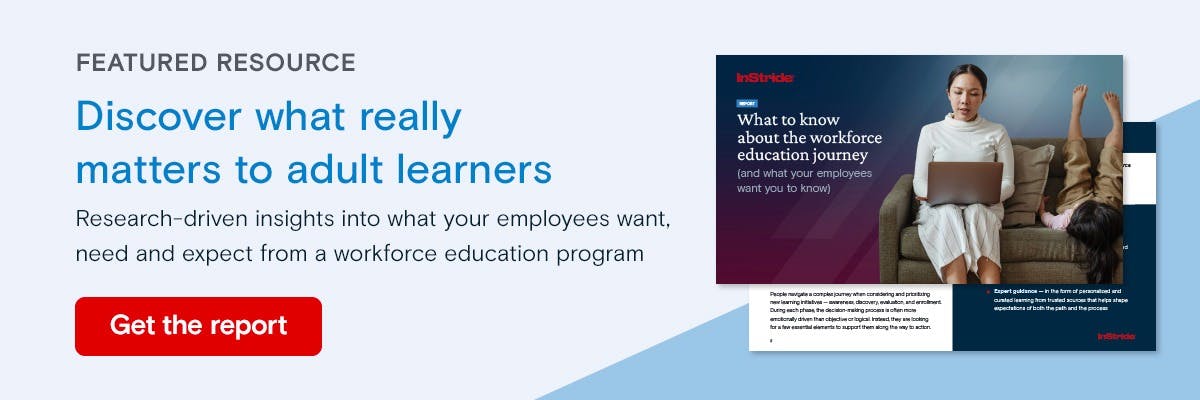The rate at which digital transformation is accelerating across industries shows no signs of slowing down. And as technologies advance, so do industry standards, business strategies and the specific skills and competencies needed to keep your workforce and organization competitive.
Business leaders know that agility needs to be built into your company objectives to keep your organization flexible and prepared for whatever the future has in store. Similarly, the cultivation of learning agility among your workforce is a critical aspect of future planning which may mean the difference between success and failure in the face of disruption.
New skills are what keep your employees and business relevant and ready for what’s next. Let’s discuss how you can enable a learning culture within your organization that’s agile and enables your workforce to stay ahead of the curve.
What is learning agility?
Put simply, learning agility is a skill that combines two elements:
- Your employees’ ability and willingness to learn, unlearn, internalize information and apply it effectively within their roles. In practice, this can look like developing new skills, updating existing ones or reskilling entirely.
- Your ability as an organization to cultivate a working environment where agile learning thrives. This includes providing access to relevant resources and programs which enable employees to develop the modern skills and competencies required to do their jobs effectively and support business growth.
Why is learning agility an important skill for the workplace?
On an individual level, being an agile learner is a strong skill to possess as it means you’re able to think on your feet and know what to do in ambiguous situations. At the organizational level, having an agile workforce that’s able to pivot at a moment’s notice is an even stronger asset — especially if your people are already armed with the skills needed to do this successfully.
Through this lens, it’s clear that agile learning, alongside skills development, is essential to the longevity of a business. That’s why people leaders prioritize workforce education and other L&D initiatives as vital aspects of their larger business strategy.
Key components of learning agility
Cultivating an employee base that’s willing and eager to learn is a key component that contributes to agility. This begins with hiring and continues with ongoing development.
Prioritizing an employee’s existing skills set and ability to learn, over educational background during the hiring process ensures that candidates will lend better flexibility to your workforce. Additionally, having this skills-based approach to hiring supports better diversity, equity and inclusion because you’re opening your prospective talent pool to candidates who may not have had access to quality education earlier in their lives.
When it comes to existing employees, it’s important to engage people managers as part of your efforts. People in leadership and management positions are closest to their direct reports and typically hold a lot of influence within the organization. To truly foster a learning culture that’s widespread, managers have to be key drivers of skills and professional development.
Employees with a high learning agility potential display a number of qualities that can indicate their propensity to seek out, internalize and apply new information. These qualities can include:
- Curiosity: They ask a lot of questions, seek out development opportunities and want to understand how their work affects the business as a whole.
- Adaptability: They can make new and old tools work for them and have a solid grasp of current operations that gives them a good foundation for future skills.
- Ingenuity: Given the right training, they can utilize new technologies and information to help them perform the tasks associated with their role.
How to develop L&D programs that enable learning agility
Not all employees have the same reasons and motivations for their desire to learn. Plus, not all employees are agile learners to begin with. People leaders need to consider the unique and often nonlinear learning journey that each employee is on.
For this reason, it’s vital to avoid taking a one-size-fits-all approach when developing your learning initiatives. Instead, consider the following:
- Include the latest information
As a people leader, it’s critical to ensure you’re partnering with learning providers or academic institutions that have coursework designed to meet in-demand skills. This ensures that employees have access to the most up-to-date information that’s highly relevant to their roles. - Provide employees with tangible outcomes
In the same way that you need to see a return on investment for your L&D programs, employees want to see a return on the time and effort they invest into learning. Motivate employees to take advantage of learning by helping them to visualize a clear path to the career advancement that can happen as a result of their efforts. - Develop customized learning pathways
The routes your employees take on their learning journeys should be unique — not only to their learning styles but also to the needs of their specific role, level of experience and educational background. - Prioritize stackable learning
No two employees have the same professional and educational background. That’s why you should prioritize stackable credentials that help employees build upon their existing skills and competencies to “stack” them towards something larger over time, such as a degree or certification. This approach to L&D enables team members to pursue learning and/or education in smaller “bite-sized” pieces, allowing for more flexibility if they’re not able to commit to a long-term program. - Leverage technology to promote accessibility
Empower your people to want to learn by providing options that are easily accessible and cater to a variety of learning styles. In today’s world, hybrid and remote work have quickly become the default for many businesses. As a result, the modern adult learner requires a solution that’s flexible and accessible from anywhere. Engage an e-learning solution that’s simple to use — both for your employees and the administrators who have to maintain it.
3 proven practices that promote ongoing learning agility
It’s likely that your organization is already on its way to building an agile workforce through your existing L&D initiatives. However, it’s always important to continuously re-evaluate your efforts and identify areas for improvement.
Here are some additional best practices to keep in mind:
- Foster a culture of learning
A learning culture means that L&D is an inherent aspect of your employee’s day-to-day life at work. It also inspires curiosity and facilitates a workplace supportive of constant improvement and forward motion. To foster this type of environment, learning has to be central to your company and its core values — starting from the top and extending to all levels. - Monitor, measure and optimize progress
People managers should regularly check in with employees to measure progress and make any necessary changes to an employee’s developmental path. Additionally, avoid development plateaus by continuously identifying ways that employees can demonstrate what they’ve learned on the job. Employees don’t need to wait until they complete their coursework or training to apply their learnings to their work. - Rethink mentorships and sponsorships
Many workplace mentorship and sponsorship programs are underutilized and ineffective. Your company leadership can additionally support employee L&D by providing direct, one-on-one guidance, practical training and feedback that will help workers prepare for future positions and competencies. This type of on-the-job support exposes employees to new perspectives and helps them become more comfortable with unfamiliar situations — boosting their ability to be agile learners as a result.
A strategic approach to learning agility
As digital transformation sweeps through industries, it’s clear that pivoting is inevitable. When the time comes for your business to make a change, your workforce’s ability to learn quickly and be agile can be factors that accelerate your company and support it through a transition. It’s worth aligning your L&D initiatives with your overall business goals to help you leverage employee curiosity, adaptability and ingenuity to the benefit of your people and organization.
Need to fast-forward your people’s learning agility and skill-building efforts? Access our step-by-step guide for practical tips on how to develop scalable and efficient reskilling and upskilling initiatives.


